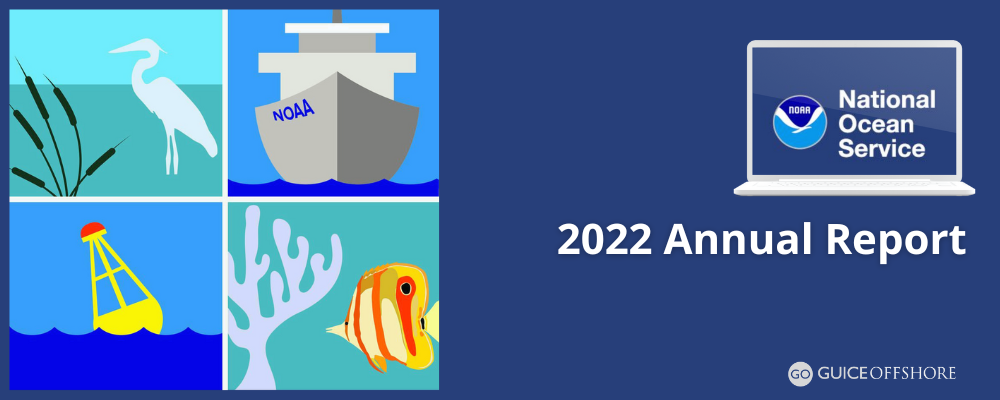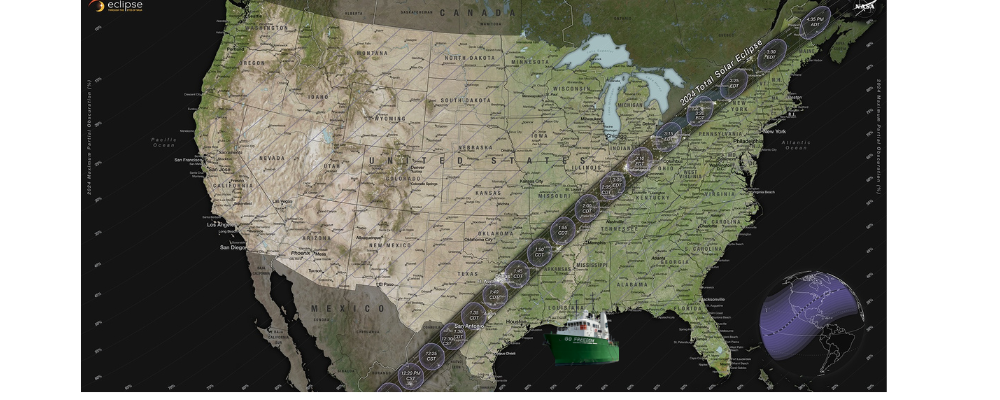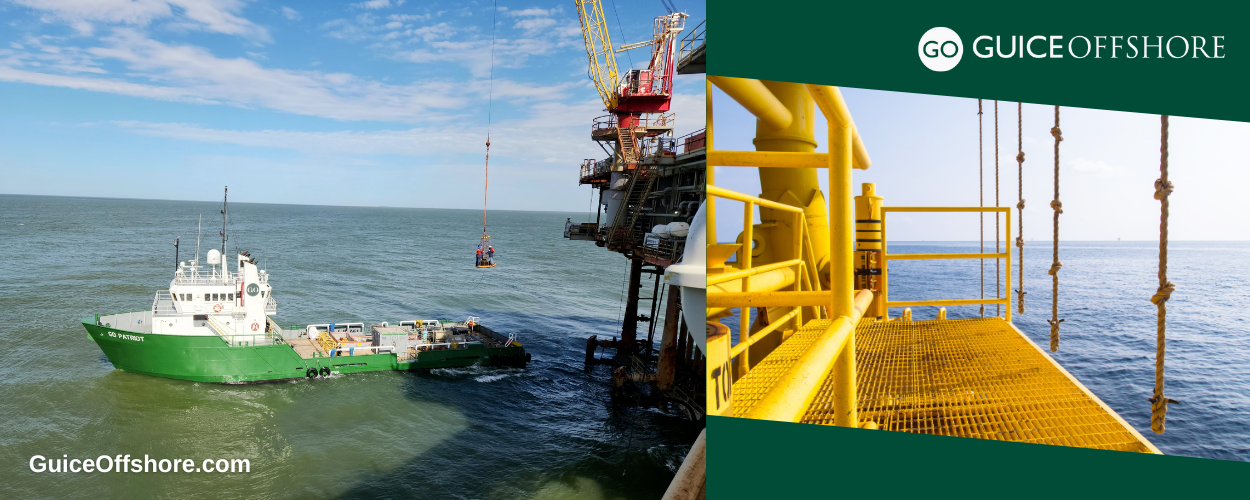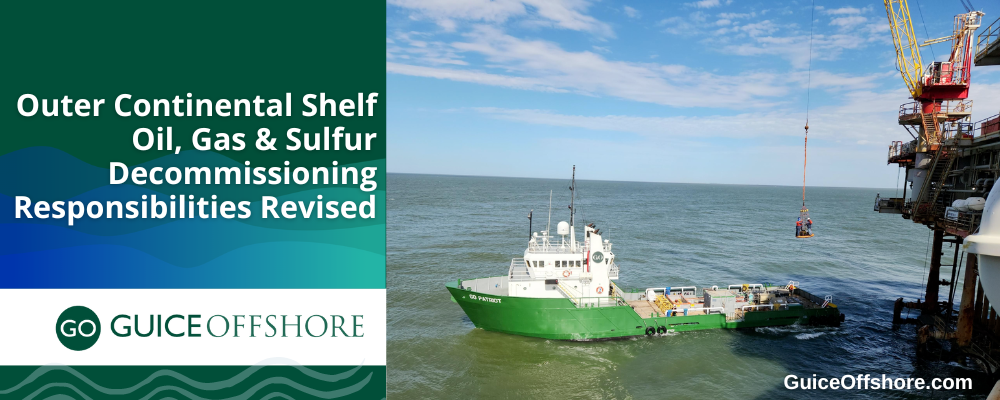Part of the National Oceanic and Atmospheric Administration (NOAA), the U.S. National Ocean Service (NOS) provides data, tools, and services that support coastal economies and their contribution to the national economy.
NOAA is part of the U.S. Department of Commerce.
The NOS is dedicated to safe and efficient transportation and commerce, preparedness and risk reduction, and stewardship, recreation and tourism.
NOS recently published its 2022 annual report, which outlines its accomplishments during fiscal year 2022 — from new spatial models to help determine the best sites for new offshore wind farms, to critical survey missions in the Great Lakes and many other innovative projects and scientific endeavors.
Some of the highlights are included below. To explore all of the NOS major accomplishments and activities more comprehensively, click HERE and choose a department list on the right-hand side of the page.
Note: A list of NOS program offices and their descriptions is provided at the bottom of the page.
National Ocean Service 2022 Annual Report Highlights
- NOS built spatial models to help determine the best sites for new offshore wind farms, identifying locations with the potential to power over three million homes.
- NOS launched new Physical Oceanographic Real-Time Systems (PORTS®) in Kitsap, Washington, and expanded PORTS sensors and stations in the Gulf of Mexico and New England.
- NOAA marked the 50th anniversary of the National Marine Sanctuaries, Marine Mammal Protection, Coastal Zone Management, and Clean Water acts with a yearlong campaign of events and advocacy.
- NOAA completed a cross-office expedition in the Mariana Islands to map and chart the seafloor, survey coral ecosystems, and gather data on environmental conditions.
- NOS launched a new SanctSound web portal that allows users to hear marine sounds, learn about the importance of sound in the marine environment, and access 300 terabytes of data.
- NOAA began using Bipartisan Infrastructure Law dollars to fund projects that support marine debris removal and interception, including a project that removed 53 tons of marine debris from Papahānaumokuākea Marine National Monument.
- NOAA’s Planet Stewards projects engaged 5,880 K-12 students, plus hundreds of educators, university students, volunteers, and family members in environmental stewardship projects.
- NOAA designated the Connecticut National Estuarine Research Reserve, the 30th site in a reserve system that facilitates partnerships, conservation, and collaborative research.
- NOS worked with Canadian surveyors to update the International Great Lakes Datum, which is critical to marine navigation, water management, mapping and shoreline planning in the Great Lakes.
- NOAA ships completed critical survey missionsin the Great Lakes, mapping parts of Thunder Bay and Wisconsin Shipwreck Coast national marine sanctuaries, and in the western Pacific, visiting areas not mapped in decades.
- NOAA and partners recovered $114 million this yearto fund restoration projects for three oil spill sites and three hazardous waste sites, helping to create accessible green spaces, coastal habitats, and urban waterways.
Additional accomplishments useful to mariners and maritime professionals include:
Office Of Coast Survey
NOS’s Office of Coast Survey (OCS) provides navigation products and services that ensure safe and efficient maritime commerce on America’s ocean and coastal waters and in the Great Lakes.
NOAA Adds 3D to Surge and Tide Operational Forecast System
The Global 3D Surge and Tide Operational Forecast System coverage in the Atlantic domain illustrates water depths with different colors.
NOS’s Surge and Tide Operational Forecast System (STOFS) became operational in late 2022. This upgrade enhances the system’s performance, resolution, and coverage for the global depth-averaged (STOFS-2D-Global) model in the western Atlantic Ocean and in the Caribbean Sea, especially along the East and West coasts, Gulf of Mexico, Puerto Rico and U.S. Virgin Islands.
This enhancement will improve water level forecast guidance, which can go out to 7.5 days at an updated rate of four times per day. As part of this upgrade, a new 3D (layered) modeling component (STOFS-3D-Atlantic) has been included into STOFS. This addition will support coastal flooding forecasting for the Atlantic basin (East Coast, Gulf of Mexico, and Puerto Rico).
The system will use input from the National Water Model to include inland hydrology and extreme precipitation effects on coastal flooding and also provide surface current information to support marine navigation.
NOS is working closely with the National Weather Service, providing technical and model output to support total water level implementation in the National Water Model. Future planned upgrades include improved spatial resolution and 3D coverage for the West Coast and Alaska.
NOAA Launches Prototype S-102 Navigation Data
In August 2022, NOAA released prototype high-resolution data for use by navigation systems in the ports of New York, New Jersey, and Los Angeles and Long Beach in California. The prototype data leverages the International Hydrographic Organization’s S-102 Bathymetric Surface Product Specification, which is optimized for use in navigation systems and displays the bathymetric surface on a separate layer, providing a greater level of detail than a regular nautical chart, and using colors and shading to show depths in between contour lines.
The S-102 standard is a critical component of the suite of Precision Marine Navigation products and services. In addition to creating product files, the data sets also maintain compliant discovery metadata that allows for machine-to-machine discovery and dissemination. Discovery metadata accompanies each data product and contains all relevant information, including boundaries and latest edition.
The S-102 prototype data for these two ports was generated from OCS’s National Bathymetric Source (NBS), a continuously updated compilation of the best available bathymetry. As NBS continues to expand its operational area, NOAA will release additional S-102 prototype data for ports within that region.
Progress on U.S. Mapping Data and Data Licensing Policy
This third annual Progress Report on Unmapped U.S. Waters shows that 52% of U.S. waters remain unmapped as of January 2022 — a decrease of 1% since January 2021. Data on the depth, shape, and composition of the seafloor is critical to exploration, sustainable development, conservation, and managing coastal and offshore ocean resources.
This progress report, compiled by NOS and released by the Interagency Working Group on Ocean and Coastal Mapping, shows that roughly 58,000 square nautical miles of new bathymetric data have been published at NOAA since the last analysis.
The 2020 National Strategy for Mapping, Exploring, and Characterizing the United States Exclusive Economic Zone and the global Seabed 2030 initiative make comprehensive ocean mapping a priority for the coming decade.
NOAA signed a memorandum of understanding in 2022 formalizing U.S. participation in Seabed 2030 and supporting NOAA’s many mission areas reliant on bathymetry.
In addition, OCS’s Data Licensing Policy is officially in place and aligns OCS with the NOAA Data Strategy and federal policies that require government data to be as free, open, and accessible as possible to spur and encourage exploration and innovation throughout the industry. This policy also requires that licensing be applied to external data contributions from the ocean mapping community.
Center for Operational Oceanographic Products and Services
NOAA’s Center for Operational Oceanographic Products and Services (CO-OPS) is the authoritative source for accurate, reliable, and timely tides, water levels, currents, and other vital coastal oceanographic and meteorological information.
Marine Channel Forecast System Launched in Mobile Bay
NOAA launched the Mobile Bay Marine Channels Forecast System, centralizing all of the region’s oceanographic and meteorological forecasts into one online location. Mobile Bay’s system is the second of its kind in the U.S. and expands the flagship 2017 Tampa Bay system into a new region in the Gulf of Mexico.
The release represents the culmination of a yearlong collaboration between NOS and National Weather Service (NWS) weather forecast offices in Mobile/Pensacola and Tampa Bay. Ship pilots transiting Mobile Bay can use the new application to view all NOS water level and tidal current forecasts alongside 24-hour NWS weather forecasts for wind, rain, marine hazard alerts, and visibility at 19 locations along the seaport. In a region frequented by fog, this information is integral for scheduling routes and piloting safely during periods of low visibility. The forecast system launched at an opportune time, just months after the development of NOAA’s new Northern Gulf of Mexico Operational Forecast System and the expansion of Mobile Bay’s PORTS.
Information provided by these three systems help ensure a flourishing U.S. economy and the safety of nearby coastal communities.
CO-OPS Improves its Coastal Hazards Products
CO-OPS significantly enhanced its suite of coastal hazards products in 2022, updating both inundation and sea level tools. As part of these efforts, CO-OPS recalculated relative sea level trends for more than 100 long-term National Water Level Observation Network (NWLON) stations and developed an interactive Sea Level Trends map in collaboration with Climate.gov.
This stand-alone tool integrates dynamic trend plots to show changes in sea level rise across NOAA’s water level network and to help coastal decision-makers better visualize near- and long-term inundation risks, from storm surge to high tide flooding.
In the wake of record and near-record Great Lakes water levels in 2019 and 2020, CO-OPS added 50 Great Lakes stations to its Coastal Inundation Dashboard. The map-based tool allows users to view water levels in real time and was invaluable for monitoring coastal flooding during Hurricane Ian and Typhoon Merbok.
NOAA’s State of High Tide Flooding and Annual Outlook report also received a geospatial facelift, transitioning from a static PDF to an interactive web map that displays local flooding predictions alongside sea level trends from the 2022 Interagency Sea Level Rise Technical Report.
With these data and tools, CO-OPS enables coastal communities to successfully plan for and mitigate risk from changing ocean conditions.
PORTS® Program Implements Major Expansions and Additions
CO-OPS substantially expanded its Physical Oceanographic Real-Time Systems (PORTS®) by enhancing seven existing systems and establishing its 37th PORTS around Naval Base Kitsap in Washington.
Developed in partnership with the U.S. Navy, the new Kitsap system equips Navy personnel and local mariners with real-time water level, current, and meteorological information critical for planning and responding to changing oceanographic conditions. This will greatly increase the navigation safety of vessels entering and exiting Puget Sound and traversing Rich Passage and Hood Canal. In the Gulf of Mexico, the Corpus Christi PORTS finalized a major expansion with the addition of new water level, currents, and visibility stations.
Other PORTS across the country completed additions and updates, including new wind sensors at Jacksonville PORTS; a new offshore current meter at Lake Charles PORTS; a new meteorological station at Narragansett PORTS; and new meteorological and salinity sensors for the Portsmouth PORTS. Both the Lower Mississippi and Cape Cod PORTS integrated data from newly installed Coastal Data Information Program wave buoys.
Real-time oceanographic and meteorological observations provided by NOAA PORTS help ensure safe navigation within U.S. waterways and represent a critical element of the nation’s data-driven blue economy.
National Water Level Observation Network Infrastructure Upgrades Fill Critical Data Gaps
Accurate, timely and reliable water level data provided by the National Water Level Observation Network (NWLON) is critical for protecting life, property, and the environment nationwide.
In 2022, CO-OPS performed repairs and replacements on NWLON stations to ensure they can withstand local environmental conditions and continue data dissemination when most needed. CO-OPS finalized construction of a reinforced, multi-pile “Sentinel of the Coast” water level station at Dauphin Island, Alabama.
The new station replaces a failing timber structure that was in operation since the 1980s and ensures real-time data is available for safe navigation and during coastal inundation events. In American Samoa, CO-OPS installed an emergency NWLON station on Tutuila Island at the Port of Pago Pago to replace a water level station removed for local construction.
The station, along with other Pacific NWLON stations, provided NOAA’s Tsunami Warning Center with critical, one-minute tsunami data from the Tonga volcanic eruption in January to help warn local communities and other Pacific Island governments. It will continue to provide real-time water level data to the government of American Samoa to inform coastal resilience planning and protect American Samoans from climate hazards.
About the National Ocean Service Departments
Safe and Efficient Transportation and Commerce
Ships move $1.5 trillion worth of products in and out of U.S. ports every year. Every ship moving in and out of U.S. ports relies on navigation charts and water level information that NOS alone provides.
All mapping, charting, and transportation activities and infrastructure are founded on a reliable, accurate national coordinate system. The NOS is solely responsible for maintaining that system, which provides more than $2.4 billion in potential annual benefits to the U.S. economy.
Businesses in the maritime community rely on NOS for a range of decisions, from how much cargo to load, to choosing the safest and most efficient route between two points. They use NOS data, tools, and services to plan seasonally for ship schedules to service global trade more safely and efficiently as significantly larger vessels transit through U.S. ports as a result of the Panama Canal expansion.
Preparedness and Risk Reduction
Coastal communities represent a major economic engine for the United States. Immediate and potentially life-threatening events such as hurricanes, as well as long-term issues like high tide flooding, are real challenges to coastal communities.
The NOS brings a unique range of information and capabilities to help communities prepare for, respond to, and recover from these events. For example, NOS maintains the nation’s network of coastal tide and water level sensors to provide real-time data that supports accurate weather forecasts, coastal storm and flood predictions, and tsunami warnings. NOS provides data and tools that enable businesses and coastal communities to better plan for and mitigate risk from changing conditions.
The agency provides information and data to protect human health and coastal economies with early warnings of harmful algal blooms and other threats. Every year, NOS responds to natural disasters and more than 150 oil and chemical spills in U.S. and state waters, which damage environments and disrupt economies.
As the authoritative resource for science related to marine debris, oil, and chemical spills, NOS provides responders with the information they need to understand the severity of a spill and where it will travel.
Stewardship, Recreation and Tourism
The United States boasts some of the most important natural, cultural, and historical resources in the world—not just on land but under the water as well. The value of the U.S. coastal tourism and recreation industry in 2009 was $62 billion.
The NOS plays a critical role in protecting and promoting access to these special coastal and marine places. NOS is entrusted with the responsibility to manage a network of underwater parks encompassing more than 600,000 square miles of coastal, marine, and Great Lakes waters.
Across all national marine sanctuaries, about $8 billion annually is generated in local economies from activities like commercial fishing, tourism, and recreation. NOS also partners with states to manage national estuarine research reserves, a network of 29 coastal sites designated to protect and study estuarine systems.
The reserves reflect the rich diversity of environments along our coasts and Great Lakes, and provide places for education, recreation, and boosting local economies.
NOAAs National Ocean Service is composed of eight program offices. Summary information for each is provided below.
· Center for Operational Oceanographic Products and Services
Looking for information on tides? The Center for Operational Oceanographic Products and Services, also known as “CO-OPS,” is where you want to head. CO-OPS and its predecessors have gathered tide information along our nation’s coasts for over 200 years.
· National Centers for Coastal Ocean Science
Science provides the foundation for making wise decisions about the use of our ocean and coastal resources. At the National Centers for Coastal Ocean Science, scientists are conducting and supporting the research, monitoring, and assessment needed to help manage coastal ecosystems and society’s use of them.
· National Geodetic Survey
While we may tend to think of the Earth as a round, smooth globe, in reality its shape and surface are quite complex. This complexity provides challenges when trying to determine the latitude, longitude, or elevation of a point on the Earth’s surface. Figuring all of this out is part of the science of geodesy. At the National Ocean Service, geodesy is the business of the National Geodetic Survey.
· Office for Coastal Management
The Office for Coastal Management helps communities adapt to a changing coast with the delivery of data, tools, and training in the Digital Coast, and through the National Coastal Zone Management Program, the National Estuarine Research Reserves, the Coral Reef Conservation Program, and the National Coastal Resilience Fund. This office builds resilience and ecosystem health with these activities and investments, and grows the next generation of coastal leaders through its fellowship programs.
· Office of Coast Survey
The Office of Coast Survey (OCS) is the nation’s nautical chart maker. OCS collects, manages, and compiles the data and information necessary to maintain the national suite of more than 1,000 nautical charts.
· Office of National Marine Sanctuaries
Did you know that around the U.S., there is a network of marine sanctuaries designed to preserve and protect some of our nation’s most valuable underwater places? Managed by the Office of National Marine Sanctuaries, the national marine sanctuary system includes 13 sanctuaries and one national monument.
· Office of Response and Restoration
When oil and chemicals are released into the environment, they are not only unsightly—they are also harmful to us and to other living things. Within NOAA, the Office of Response and Restoration is tasked with providing the science and information needed to support the U.S. Coast Guard during spills and in coordinating with federal, state, and tribal natural resource trustees to restore coastal resources damaged by those spills.
· U.S. Integrated Ocean Observing System
When it comes to monitoring our nation’s ocean, coasts, and Great Lakes, the U.S. Integrated Ocean Observing System (U.S. IOOS®) plays a key role. Composed of partners from federal, regional, private sector, and academic organizations, IOOS is a network of tools to track, predict, manage, adapt, and respond to changes in our marine environment in order to protect lives, property, and the environment
About Guice Offshore
Guice Offshore (GO) regularly tracks maritime developments and news of interest to our valued customers as part of our thought leadership, and commitment to quality and excellence.
With our fleet of 15 mini supply vessels, multi-purpose vessels and offshore supply vessels, Guice Offshore provides vessel and technical services to a broad spectrum of critical industries like aerospace, documentary and film; oil and gas; government and military; environmental and disaster response and recovery; inspection, maintenance and repair (IMR); science and research; ocean salvage; geotechnical and surveys; and offshore wind and renewable energy. Our “GO Safely” culture is customer driven with a strong “Can Do Safely” mentality.
We address our clients’ needs with a technical approach, enhanced vessel capabilities and experienced crews. Our goal is to consistently deliver safe, reliable and cost-effective service.



